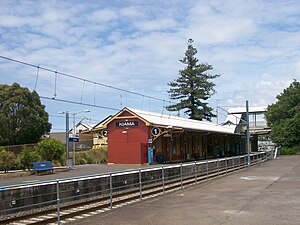Kiama railway station
|
Kiama
|
|
|---|---|
|
NSW TrainLink intercity train station ← Bombo · Gerringong → |
|
 |
|
| Location | Railway Parade, Kiama New South Wales Australia |
| Coordinates | 34°40′20″S 150°51′17″E / 34.6723°S 150.8548°ECoordinates: 34°40′20″S 150°51′17″E / 34.6723°S 150.8548°E |
| Owned by | RailCorp |
| Operated by | NSW TrainLink |
| Line(s) | South Coast |
| Distance | 119.160 km from Central |
| Platforms | 2 (island), 194 and 196 metres |
| Train operators | NSW TrainLink |
| Bus operators |
|
| Construction | |
| Structure type | At-grade |
| Parking | 40 spaces |
| Bicycle facilities | Yes |
| Disabled access | Easy Access |
| Other information | |
| Website | Sydney Trains |
| History | |
| Opened | 2 June 1893 |
| Electrified | 17 November 2001 |
| Traffic | |
| Passengers (2014) | 115,376 |
| Rank | 192nd of 307 |
Kiama is an intercity train station located in Kiama, New South Wales, Australia, on the South Coast railway line. The station serves NSW TrainLink diesel multiple unit trains travelling south to Bomaderry and electric multiple unit trains north to Wollongong and Sydney.Premier Illawarra and Kiama Coaches operate connecting bus services to the surrounding towns of Gerroa, Jamberoo and Shellharbour. Early morning and late night services to and from stations to the south are provided by train replacement bus services. Kiama Station is listed on the state heritage register.
As a seaside town, Kiama was initially reliant on coastal shipping for its links to Wollongong and Sydney. The railway first arrived in the Kiama district in November 1887, with the opening of a new station at North Kiama (since renamed Bombo), on the town's northern outskirts. The terminus was only a temporary arrangement, however: the NSW Government Railways had already signed contracts to further extend the railway south the previous year. Kiama was the northernmost station on that extension, built by firm of W. Monie & J. Angus between 1886 and 1893. The new station opened in June 1893. The station precinct included the passenger station building and island platform that exist today, plus a substantial goods yard to the south built to serve the local pastoral and dairy industries – though all that remains of the yard is a turntable, an ash pit and some remnant track. The station building is significant in that it became the model for island platform stations built in NSW over the following 30 years.
...
Wikipedia
